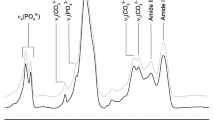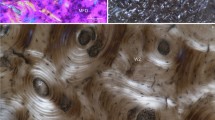Abstract
When estimating post-mortem interval (PMI) in forensic anthropology, the only method able to give an unambiguous result is the analysis of C-14, although the procedure is expensive. Other methods, such as luminol tests and histological analysis, can be performed as preliminary investigations and may allow the operators to gain a preliminary indication concerning PMI, but they lack scientific verification, although luminol testing has been somewhat more accredited in the past few years. Such methods in fact may provide some help as they are inexpensive and can give a fast response, especially in the phase of preliminary investigations. In this study, 20 court cases of human skeletonized remains were dated by the C-14 method. For two cases, results were chronologically set after the 1950s; for one case, the analysis was not possible technically. The remaining 17 cases showed an archaeological or historical collocation. The same bone samples were also screened with histological examination and with the luminol test. Results showed that only four cases gave a positivity to luminol and a high Oxford Histology Index (OHI) score at the same time: among these, two cases were dated as recent by the radiocarbon analysis. Thus, only two false-positive results were given by the combination of these methods and no false negatives. Thus, the combination of two qualitative methods (luminol test and microscopic analysis) may represent a promising solution to cases where many fragments need to be quickly tested.




Similar content being viewed by others
References
Taylor RE, Suchey JM, Payen LA, Slota PJ Jr (1989) The use of radiocarbon (C-14) to identify human skeletal materials of forensic science interest. J Forensic Sci 34(5):1196–1205
Dirkmaat DC, Cabo LL, Ousley SD, Symes SA (2008) New perspectives in forensic anthropology. Am J Phys Anthropol Suppl 47:33–52
Cook SF, Heizer RF (1953) Archaeological dating by chemical analysis of bone. Southwest J Anthropol 9:231–238
Cook SF (1968) Dating prehistoric bone by chemical analysis. In: Heizer R, Cook SF (eds) The application of quantitative methods in archaeology. Viking Fund Publications in Anthropology, Chicago, pp 223–245
Marchiafava V, Bonucci E, Ascenzi A (1974) Fungal osteoclasia: a model of dead bone resorption. Calcif Tissue Res 14(3):195–210
Hackett CJ (1981) Microscopical focal destruction (tunnels) in exhumed human bones. Med Sci Law 21(4):243–265
Bell LS, Skinner MF, Jones SJ (1996) The speed of post-mortem change to the human skeleton and its taphonomic significance. Forensic Sci Int 82(2):129–140
Yoshino M, Kimijima T, Miyasaka S, Sato H, Seta S (1991) Microscopical study on estimation of time since death in skeletal remains. Forensic Sci Int 49(2):143–158
Berg S (1963) The determination of bone age. In: Landquist F (ed) Methods of forensic sciences, vol. 2. Interscience, pp 231-252.
Knight B, Lauder I (1969) Methods of dating skeletal remains. Hum Biol 41(3):322–341
Knight B, Lauder I (1967) Practical methods of dating skeletal remains: a preliminary study. Med Sci Law 7(4):205–209
Castellano MA, Villanueva EC, von Frenckel R (1984) Estimating the date of bone remains: a multivariate study. J Forensic Sci 29(2):527–534
Facchini F, Pettener D (1977) Chemical and physical methods in dating human skeletal remains. Am J Phys Anthropol 47(1):65–70
Ramsthaler F, Ebach SC, Birngruber CG, Verhoff MA (2011) Postmortem interval of skeletal remains through the detection of intraosseal hemin traces. A comparison of UV-fluorescence, luminol, Hexagon-OBTI ®, and Combur® tests. Forensic Sci Int 209(1–3):59–63
Introna F Jr, Di Vella G, Campobasso CP (1999) Determination of postmortem interval from old skeletal remains by image analysis of luminol test results. J Forensic Sci 44(3):535–538
Ramsthaler F, Kreutz K, Zipp K, Verhoff MA (2009) Dating skeletal remains with luminol-chemiluminescence. Validity, intra- and inter-observer error. Forensic Sci Int 187(1–3):47–50
Creamer JI, Buck AM (2009) The assaying of haemoglobin using luminal chemiluminescence and its application to the dating of human skeletal remains. Luminescence 24(5):311–316
Taylor RE (1982) Problems in radiocarbon dating of bone. In: Currie LA (ed) Nuclear and chemical dating techniques: interpreting the environmental record. DC pp, American Chemical Society, Washington, pp 453–473
Ubelaker DH, Buchholz BA, Stewart JE (2006) Analysis of artificial radiocarbon in different skeletal and dental tissue types to evaluate date of death. J Forensic Sci 51(3):484–488
Ubelaker DH, Buchholz BA (2006) Complexities in the use of bomb-curve radiocarbon to determine time since death of human skeletal remains. Forensic Sci Commun 8(2):1–9
Ubelaker DH, Parra RC (2011) Radiocarbon analysis of dental enamel and bone to evaluate date of birth and death: perspective from the southern hemisphere. Forensic Sci Int 208(1–3):103–107
Cardoso HF, Puentes K, Soares AM, Santos A, Magalhães T (2012) The value of radiocarbon analysis in determining the forensic interest of human skeletal remains found in unusual circumstances. J Forensic Leg Med 19(2):97–100
Hoke N, Grigat A, Grupe G, Harbeck M (2013) Reconsideration of bone post-mortem interval estimation by UV-induced auto-fluorescence. Forensic Sci Int 228(1-3)176.e1-e6
McLaughlin G, Lednev IK (2011) Potential application of Raman spectroscopy for determining burial duration of skeletal remains. Anal Bioanal Chem 401(8):2511–2518
Howes JM, Stuart BH, Thomas PS, Raja S, O'Brian C (2012) An investigation of model forensic bone in soil environments studied using infrared spectroscopy. J Forensic Sci 57(5):1161–1167
Patonai Z, Maasz G, Avar P, Schmidt J, Lorand T, Bajnoczky I, Marl L (2013) Novel dating method to distinguish between forensic and archeological human skeletal remains by bone mineralization indexes. Int J Leg Med 127(2):529–533
MacLaughlin-Black SM, Herd RJ, Willson K, Myers M, West IE (1992) Strontium-90 as an indicator of time since death: a pilot study investigation. Forensic Sci Int 57(1):51–56
Swift B (1998) Dating human skeletal remains: investigating the viability of measuring the equilibrium between 210Po and 210Pb as a means of estimating the post-mortem interval. Forensic Sci Int 98(1–2):119–126
Neis P, Hille R, Paschke M, Pilwat G, Schnabel A, Niess C, Bratzke H (1999) Strontium90 for determination of time since death. Forensic Sci Int 99(1):47–51
Swift B, Lauder I, Black S, Norris J (2001) An estimation of the post-mortem interval in human skeletal remains: a radionuclide and trace element approach. Forensic Sci Int 117(1–2):73–87
Schrag B, Uldin T, Mangin P, Froidevaux P (2012) Dating human skeletal remains using a radiometric method: biogenic versus diagenetic 90Sr and 210Pb in vertebrae. Forensic Sci Int 220(1–3):271–278
Yoshino M (1991) Microscopic and chemical examinations for estimating the time since death of skeletal remains its application to forensic cases. Nihon Hoigaku Zasshi 45(5–6):379–92
Jans MME, Nielsen-Marsh CM, Smith CI, Collins MJ, Kars H (2004) Characterisation of microbial attack on archaeological bone. J Archaeol Sci 31:87–95
Trueman CN, Martill DM (2002) The long-term survival of bone: the role of bioerosion. Archaeometry 44(3):371–382
Hedges REM, Millard AR (1995) Measurements and relationships of diagenetic alteration of bone from three archaeological sites. J Archaeol Sci 22(2):201–209
Weber K (1966) Die Anwendung der Chemilumineszenz des Luminols in der gerichtlichen Medizin und Toxikologie. Deutsch Zeitschr Gesamtegerichtl Med 57(3):410–423
Calcagnile L, Quarta G, Cattaneo C, D’Elia M (2013) Determination of the radiocarbon content in different human tissues: implications for the application of the 14c bomb spike dating in Forensic Medicine, Radiocarbon, University of Arizona, Vol. 55 Nr. 2-3, 1845-1849
Quarta G, Butalag K, Calcagnile L, D'Elia M, Arthur P, Tinelli M, Caramia A, (2008) IBA analyses of major and trace elements of AMS 14C dated bones from two medieval sites in Italy, Nuclear Instruments and Methods in Physics Research B Vol. 266 pp. 2343-2347
Stuiver M, Polach HA (1977) Discussion: reporting of 14C data. Radiocarbon 19(3):35–363
Haynes CV (1967) Bone organic matter and radiocarbon dating in radiocarbon dating and methods of low level counting. International Atomic Energy Agency, Vienna, pp 163–168
Olsson IU, Farid M, El-Daoushy AF, Abdel-Mageed AI, Klasson M (1974) A comparison of different methods for pretreatment of bones. Geol Forensics (Stockholm) 96(2):171–181
Hoke N, Burger J, Weber C, Benecke N, Grupe G, Harbeck M (2011) Estimating the chance of success of archaeometric analyses of bone: UV-induced bone fluorescence compared to histological screening. Palaeogeogr Palaeoclim Palaeoecol 310:23–31
Ethical standards
The authors declare that the present study comply with the current Italian laws.
Conflict of interest
The authors declare that they have no conflict of interest.
Author information
Authors and Affiliations
Corresponding author
Rights and permissions
About this article
Cite this article
Cappella, A., Gibelli, D., Muccino, E. et al. The comparative performance of PMI estimation in skeletal remains by three methods (C-14, luminol test and OHI): analysis of 20 cases. Int J Legal Med 132, 1215–1224 (2018). https://doi.org/10.1007/s00414-015-1152-z
Received:
Accepted:
Published:
Issue Date:
DOI: https://doi.org/10.1007/s00414-015-1152-z




